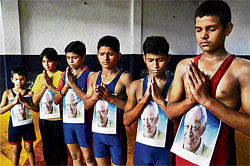
Dara Singh was Indian cinema’s reply to Hollywood’s Charlton Heston of the “Ten Commandments” fame. He was one of those “muscular hunks” to have graced the Indian cinema, who abstained from alcohol and steroid intake.
Invited to wrestle in “akhadas” patronised by princely states and zamindars, Dara Singh in the 50s spread his wings to the far east nations. Popularising “pehlwani” abroad, he competed with some of the biggest professional wrestlers of his times.
Even as he began hopping from one country to another, learning the business of “professional wrestling,” Dara Singh carried an image of a “vice-less traditional Indian wrestler.”
He soon forayed into cinema and featured in some forgettable Hindi action flicks.
In late 50s and early 60s, Indians, trapped in the societal flux, sought solace in the past-the result was an array of C-grade fantasy and mythological flicks. Dara Singh fitted the bill of the leading protagonist.
By the late 60s, the changing societal norms, juxtaposed with economic crisis, led to the churning of popular films focussed on escapist romantic themes. By then, Dara Singh had become a household name and epitomised “massive physique and courage.” It was at this juncture that he withdrew from films.
Along with other professional Indian and foreign wrestlers, he launched in India the “eye-ball grabbing, slam bang loud rhetoric staged scuffle” in Mumbai. The staged fights took the country by storm and every street in the city saw posters displaying garishly dressed, masked wrestlers.
For two decades, the “staged fights” remained popular, till mythological films and television serials regained popularity. Dara Singh, with his clean image, re-emerged, to play Hanuman in the serial “Ramayana.” The raw sensuality portrayed by him in the role of Hanuman, till date continues to adorn the pop-calendar art at every temple street and probably will continue to do so.